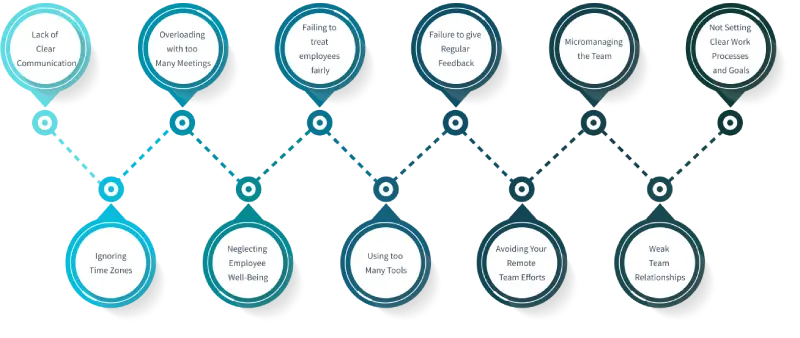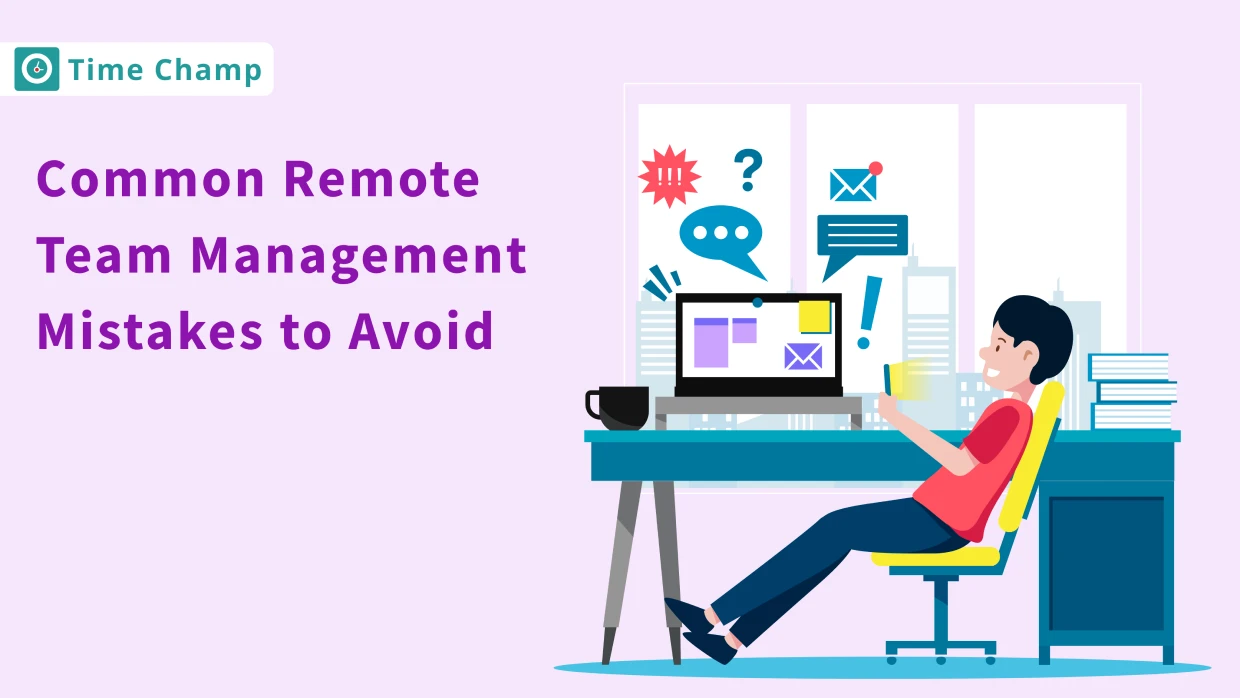If you find it hard to manage a
remote team, you might be making
some common mistakes. Yes! Managing
a remote team
offers great opportunities, but it
also comes with unique challenges.
The good news is that by identifying
and avoiding these mistakes, you can
create a smoother, more efficient,
and motivated remote
team.
Let’s explore
some common remote team management
mistakes and how to fix them!

1. Lack of Clear Communication
You might just think communication
will automatically flow, and
everything will be fine, but it’s
not the case. Communication
is one of the biggest
challenges that a remote
worker faces. According to a study,
a large number of remote workers
struggle with communication, and
about 41% say it lowers their
productivity.
Nobody wants to
decrease their employees’
productivity, right?
Why Remote Communication Fail?
Remote employees usually lack direct interaction with their colleagues which occurs naturally in in-office settings. Without proper interaction, there is a high chance that misunderstandings can pile up quickly. It can lead to missed deadlines, frustrations, etc. Some employees hesitate to ask for clarification or feel disconnected from the team. Some common reasons are:
-
Unclear Expectations: If employees don’t know what to do and when to do it, they may struggle to complete tasks effectively.
-
Too Many Communication Tools: Switching from different communication channels to chat for a while, to call for a while is hectic. It can create confusion and information overload.
-
Different Communication Styles: Some remote employees prefer verbal communication while some may prefer written communication. If you fail to recognize these differences, it may lead to misalignment.
How to Avoid These Mistakes?
-
Make sure to understand your employee’s communication styles, challenges, etc. through meetings.
-
Conduct one-on-one meetings frequently to get real-time feedback from your employees.
-
Virtual Q&A sessions should be scheduled regularly to explain tasks, expectations and key deadlines which help teams work together efficiently.
-
Establish rules on response time, communication tools, and when to use meetings to avoid any type of confusion.
2. Ignoring Time Zones
Remote work includes people working from different time zones which makes synchronization a big challenge. Ignoring time zones can lead to delayed responses, frustration, and lack of collaboration. When you are about to schedule a meeting or any plan, make sure to check every employee’s time zone. If meetings are scheduled at inconvenient times, employees may burnout and feel pressured to join.
Impact of Time Zone Misalignment
-
Delays in Decision-Making: When teams are spread across the globe, the response time from every colleague is difficult as they will be in different time zones which slows down project progress.
-
Burnout and Work-life Imbalance: Employees may feel stressed to join meetings outside of their working hours. This is not a good practice as it disrupts their personal time.
-
Communication Gaps: If an employee sends a message to others while they are offline, critical information might get missed.
-
Reduces Team Collaboration: Real-time teamwork is difficult when team members aren’t available together. Different employees with various time zones might find it difficult to collaborate together.
How to Avoid These Mistakes?
-
To avoid this, put core working hours that overlap across locations.
-
Make use of scheduling tools such as Google Calendar, etc., to coordinate meetings effectively.
-
Rotate schedules to prevent any team from constantly attending meetings at difficult hours.
-
Set some clear guidelines on response time. For instance, a 24-hour rule, to make sure of timely replies.
3. Overloading with Too Many Meetings
Yes, it is your responsibility to get updates from your employees. But it doesn’t mean that you have to schedule a meeting every hour. Conducting too many meetings can irritate employees and drain their productivity. Too many meetings can disrupt their work, increasing the chances of missing deadlines due to these unnecessary interruptions.
The Problem with Too Many Meetings
For instance, if an employee is busy with his work and all of a sudden he gets a request to join a meeting. Imagine how it feels! It disrupts his work and most importantly he might lose his workflow. According to research from the University of California, Irvine, shows that after a distraction, it takes about 23 minutes to refocus. These frequent meetings not only waste time but also irritate your employees.
End Meeting Overload with Time Champ!
Minimize meetings, maximize productivity, and keep your team on track. Try Time Champ today!
Signup for FreeBook DemoA Smarter Approach: Fewer but Effective Meetings
-
Weekly Stand-ups : Instead of conducting ‘n’ meetings daily, try to focus on organizing weekly stand-ups which are way more effective. These are short, structured meetings without wasting any time.
-
Asynchronous Communication: Use tools such as Slack, etc. for quick and short updates instead of an unnecessary meeting.
-
Defined Meeting Agenda: Every single meeting should have a clear purpose, time limit, and action items to ensure efficiency.
-
Meeting-free Days: Schedule some “focus” days where there will be no meetings for employees. It lets them focus on their work without any interruptions.
4. Neglecting Employee Well-Being
Never allocate much work to remote
employees just because they are
working from home. Remote employees
often struggle to manage both their
personal and professional
lives. Working from home
usually blurs the line between
personal and professional life.
Gallup’s
research shows that
loneliness varies by work setup. It
affects 25% of remote workers, 16%
of on-site employees, and 21% of
hybrid workers. So, basically, this
is a clear sign that companies need
to do more to support their teams.
If managers don’t take care of their
employees, they can’t expect them to
stay motivated.
Consequences of Ignoring Employee Well-Being
-
Stress & Burnout: Remote employees usually feel stressed about staying online which leads to exhaustion.
-
Lowers Productivity: Employees who feel stressed are less productive than employees with good rest.
-
Decreases Job Satisfaction: If employees don’t feel valued or supported, they’re more likely to resign from their jobs and start looking for new opportunities.
How to Prioritize Employee Well-Being?
-
Put some fixed working hours and avoid after-hours email to help employees disconnect.
-
Conduct wellness programs, and sessions, or give access to some courses.
-
Give ‘paid leaves’, support short breaks, and organize ‘no meeting days’ for better focus.
-
Allow employees to work at times that suit their personal and family needs.
-
Organize some virtual coffee breaks, team-building activities, and in-person meet-ups.
5. Failing to Treat Employees Equally
In remote teams, everyone deserves
equal opportunity in every aspect of
work. Showing favouritism can make
team members feel left out,
frustrated, demotivated, ignored. If
some people are treated better than
others in similar cases, it can make
them feel unfairly treated, decrease
their morale, and lead to legal
problems over discrimination by
race, gender, age, or other reasons.
Why should some employees get
special treatment when everyone is
doing their part to help the team
succeed?
Who gets lost by
doing all this stuff?
In the
end, the organization will suffer if
this practice continues.
Consequences of Failing to Treat Employees Equally
-
Low employee engagement
-
Damage to company reputation
-
Legal risks
-
Negative workplace culture
How to Treat Employees Equally?
-
Have simple and fair ways to check employee performance for raises and promotions.
-
Clearly explain the reasons behind promotions and salary increases to avoid confusion.
-
Appreciate employees for the work they do based on their efforts and achievements, whether they work remotely or in-office.
-
Create a safe environment for employees to share their thoughts, problems, and speak about unfair treatment openly without any fear.
-
Make sure that all employees have access to courses, training, career development, etc.
-
Regularly check workplace decisions to prevent favouritism and unconscious bias.
6. Using Too Many Tools
Tracking remote employees’ work is important, but relying on too many tools can backfire. Constantly switching between different tools can make employees irritated, create confusion, and decrease productivity.
Why Using Many Tools Can Hurt Productivity?
-
Higher costs- Maintaining various tools can be very expensive and increases company expenses.
-
Lack of Integration- Some tools don’t sync properly, which can lead to miscommunication.
-
Creates confusion, Managing different tools at a time causes unnecessary complexity.
-
Wastes Time- Switching between multiple tools can waste time. Sometimes, tools may take some time to load the data and slow the process as well.
Too Many Tools, Less Productivity!
Streamline your workflow and stay efficient with the right solutions today!
Signup for FreeBook DemoHow to Fix this Issue?
-
Identify relevant tools and keep only essential ones.
-
Choose tools that work well together.
-
Make sure to check prices as well and adopt a tool which suites best for your needs.
-
Give proper training to your employees about the tool and tell them all the benefits that it provides.
7. Failure to give Regular Feedback
Remote employees usually need consistent
feedback as it provides the
areas for improvement to get better.
Unlike in-office, >remote
employees lack direct
interaction which makes it difficult
to gauge their performance.
Without any regular feedback,
employees may:
-
Continue to perform the same, which leads to lower quality of work.
-
Feel disconnected and motivated.
-
Struggle to understand expectations which results in misalignment with company goals.
How to Give Effective Feedback?
-
Schedule regular one-on-one meetings to discuss their challenges, pain-points, feedbacks, performance, etc.
-
Use some structured feedback methods such as SBI method, sandwich approach, etc. for better clarity.
-
Encourage peer-to-peer feedback for collaboration and learning.
Feedback can be praised when employees excel in their work. It actually helps to bring confidence and positive behaviour.
8. Avoiding Your Remote Team Efforts
Every employee wants to feel
appreciated by their leaders.
Usually, in office, it is simple to
recognize hard work of the employees
as it would be seen by
employers.
But, for remote
employees, it’s not the case! According
to the study, 79% of
employees quit their jobs due to
lack of appreciation.
Isn’t it
sad?
They’re often unseen and
underappreciated. This can hurt
their motivation and overall team
spirit.
But, what happens when
you ignore this?
Consequences of Avoiding Remote Teams Effort
-
Low employee morale and engagement
-
Isolation and being undervalued
-
High turnover rates due to no recognition
-
Drastically reduces productivity
Here, are some effective tactics to consider:
-
Appreciate employees through written documents such as sending emails, messages in groups, etc.
-
Conduct online gathering sessions to celebrate individual’s contributions and success
-
Reward top performer on a monthly or annual basis with bonuses
-
Try to offer some additional benefits such as vocational leaves, etc.
9. Micromanaging the Team
Tracking your remote employee’s activity is fine, but excessive monitoring can have the opposite effect. Micromanaging can make employees feel distrusted, frustrated, and unmotivated. When organizations focus on hours instead of results, employees will be more concerned about pleasing their manager instead of bringing their best. This can lead to burnout and decreased productivity.
Why Micromanaging Hurts Remote Team?
-
Kills creativity- Employees feel restricted and won’t take initiative, which slowly hinders creativity.
-
Reduces productivity – Constant check-ins for every half an hour disrupts employee’s workflow.
-
Creates stress & anxiety- Employees feel pressured to work as they keep on thinking about micromanaging all the time.
-
Breaks trust- A lack of autonomy makes employees feel undervalued.
Then, How to Fix This Issue?
-
Focus on results, not the amount of hours they have worked.
-
Instead of regular monitoring, try to schedule some meetings about progress updates.
-
Guide employees on everything rather than pointing them for every minor mistake.
10. Weak Team Relationships
One of the worst drawbacks of remote work is poor team relationships. Unlike in-office environment where employees build relationships while coffee chats, informal talks, etc. remote work doesn’t have anything. They often feel disconnected due to limited face-to-face interactions.
Consequences of Weak Team Relationships
-
Loneliness and lower morale
-
Miscommunication and missed deadlines
-
Reduces engagement and weakens investment in company culture
-
Lack of belonging
How to Strengthen Team Relationships?
-
Not every meeting should be about work! Conduct some meetings for informal talks, chit-chats to build strong relationships.
-
Try to organize some virtual team-building activities. It can be of anything such as quizzes, puzzles, monthly challenges, etc.
-
Encourage employees to discuss something outside of work such as movies, games, etc.
-
If budget permits, weekend retreats or occasional meet-ups can strengthen the bond.
11. Not Setting Clear Work Processes and Goals
Clear goals and expectations are the
root of success. Without any clear
goals and processes, it can cause
confusion, missed deadlines and
decreased productivity in remote
teams. Usually, remote employees
seek clarification but instead, all
they get is unclear goals and
processes.
Without clear work
processes and goals, employees may:
-
Wastes time spending on unnecessary activities, or trying to figure out what to do
-
Experiences much delays in work due to unclear roles and responsibilities
-
Feel demotivated due to unclear expectations
How to Set Clear Expectations and Goals?
-
Make sure to define roles and responsibilities with clear descriptions, tasks, deadlines, etc.
-
Use SMART goals to convert objectives into specific, measurable, achievable, relevant, and time-bound targets.
-
Conduct regular one-on-one reviews, check-ins, and weekly updates for short-term goals. For long-term goals, try to conduct monthly or quarterly reviews.
-
Focus on results, not on hours!
Final Thoughts
In conclusion, effective remote team management requires clear communication, respect for time zones, balanced meetings, and employee well-being. Using simple tools, giving feedback often, building good team bonds, and setting clear goals help employees stay focused and motivated. Companies that avoid these common mistakes can use them to establish a powerful, motivated, and efficient remote workforce.
Manage your remote team the right way!
Avoid common mistakes and boost productivity with Time Champ. Try it today!
Signup for FreeBook DemoFrequently Asked Questions
Many people prefer remote work as it gives the flexibility, good work-life balance, and saves time and money as well on commuting, which makes it as perfect choice for many.
Yes! It actually improves communication, productivity, strengthens teamwork, and keeps employees motivated which leads to a more successful remote team.
New managers often struggle between over-controlling their teams and not providing enough support. Remote leaders must find the middle ground for success.
To make virtual meetings more engaging, make it short and try to use polls and Q&A sessions. This allows employees to share their thoughts freely to boost engagement.






